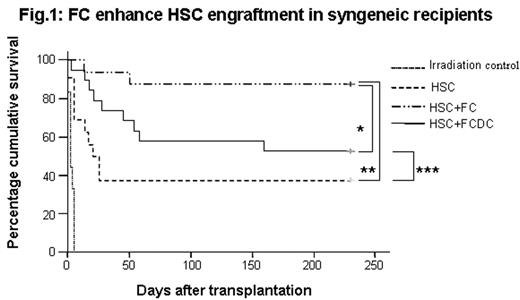Abstract
The discovery of cells with facilitative property offers great therapeutic potential in hematopoietic stem cell (HSC) transplantation. CD8+/TCR− facilitating cells (FC) enhance engraftment of HSC in allogeneic recipients without causing GVHD and also significantly enhance the engraftment of limiting numbers of HSC in syngeneic recipients. We recently identified that plasmacytoid precursor dendritic cells (p-preDC), the main component of the heterogeneous FC population, contribute to facilitation, but with less efficiency than the total FC population. In the present study we determined the role p-preDC play in the ability of FC to 1) enhance syngeneic suboptimal HSC engraftment and 2) maintain HSC clonogenicity in vitro. 500 syngeneic HSC +/− 30,000 FC, or p-preDC from the FC (DC-FC) were transplanted into ablated (950 cGy) B6 mice. As expected, FC significantly increased HSC engraftment, with 87.5 % of recipients (n=19) surviving at 250 days after transplantation, while recipients of HSC alone exhibited significantly impaired survival (37.5%, P=0.0026, n=16) (Figure 1). However, DC-FC, which allowed a slight improvement of HSC engraftment (52.6% recipient survival, n=16, P=0.15), were significantly (P=0.034) less effective than total FC. These data show that DC-FC are less effective than FC total. We then evaluated the influence of p-preDC and DC-FC on HSC in vitro using the colony forming cell (CFC) assay that enumerates progenitors in the HSC population. HSC were cultured in the presence or absence of FC, p-preDC or DC-FC (at 1:3 ratio) in methylcellulose containing growth factors for 14 days. The number of CFC was significantly increased when HSC were cultured in the presence of FC (P<0.01) compared to HSC alone (Figure 2). In contrast, the DC-FC slightly increased clonogenicity, as did p-pre-DC, but did not replace FC total. Moreover, when we preincubated HSC with FC, DC-FC or p-pre-DC for 18 hour and assessed in the CFC assay, FC significantly increased the number of CFC although no significant effect was observed with DC-FC or p-pre-DC (Figure 2). These data suggest that the effect of FC on HSC clonogenicity and HSC engraftment is only partially due to the contribution of the DC subpopulation, and that this effect on HSC requires synergistic interactions between the cells within the FC population. Moreover these data also suggest that FC facilitation on HSC involves a combination of different mechanisms: one on host alloreactivity due likely to DC-FC and one on direct interaction with HSC due to combined effects of cells in the FC.
Author notes
Corresponding author



This feature is available to Subscribers Only
Sign In or Create an Account Close Modal